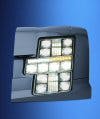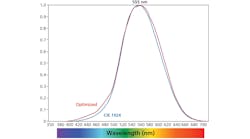LEDs offer design and styling options as well as long lifetime which leads to low or zero maintenance. Other factors valued by vehicle OEMs are space savings and efficiency, while customers appreciate added safety, higher performance, cost reduction and reliability.
Eichhorn estimated that low-beam headlamps can require a luminous flux ranging from 350 to 1000 lm, which means about 45 LED chips today, and 19 chips in 2006. Multichip LED arrays will lead to headlamps incorporating functions such as the ability to illuminate around corners as the vehicle turns. However, the introduction of LED-based headlamps is dependent on legislative, as well as cost/performance, issues.
Mallory concluded his talk with a summary of requirements for LEDs in automotive applications. Red LEDs are expected to reach a luminous flux of 100 lm at a cost of less than $2, while amber needs to reach 240 lm at less than $4. White LEDs need to reach targets of 150 lm and 100 lm/$; other speakers at the conference indicated that the latter figure is around 10 lm/$ today.







